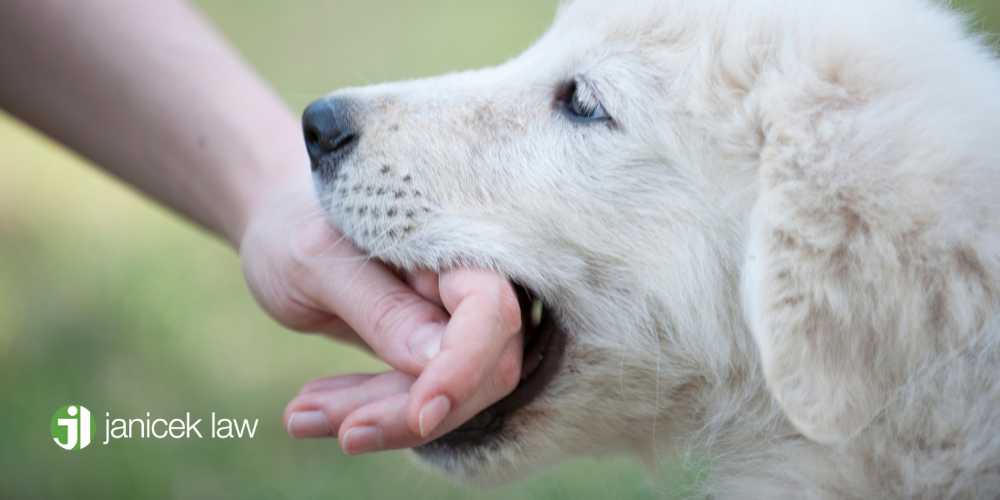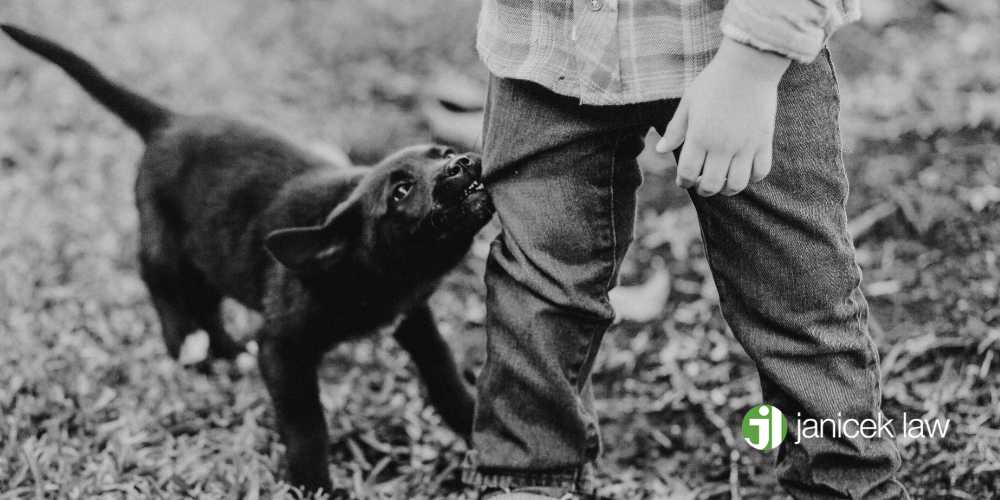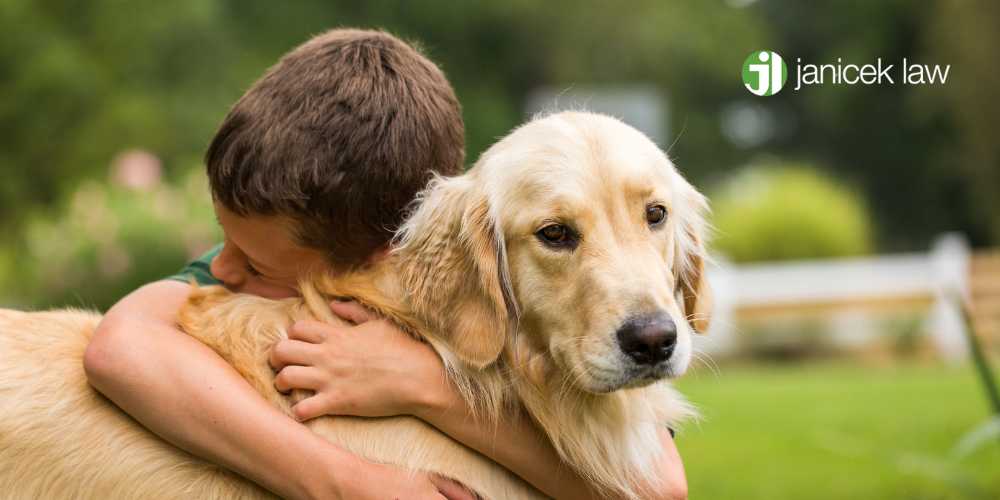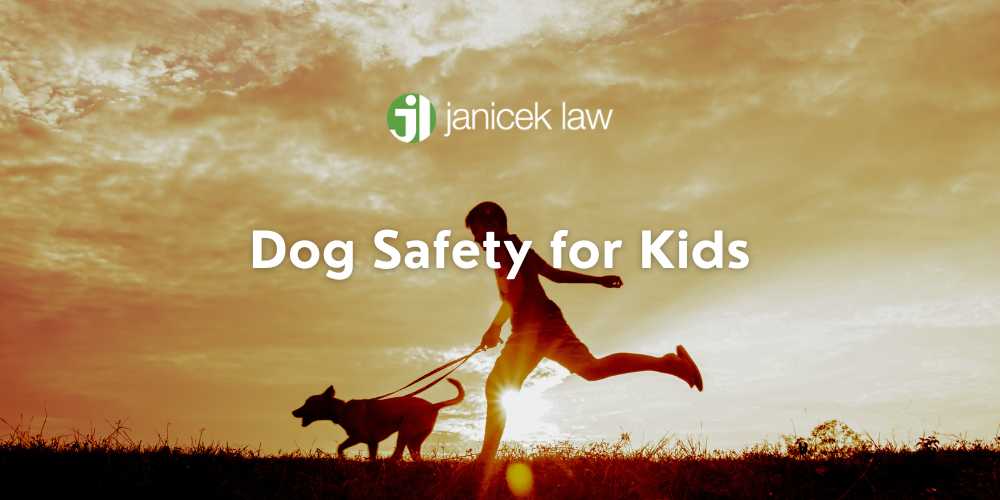Parents with a small child want to do everything they can to protect the youngest members of their family. Unfortunately, kids can suffer from a number of injuries both in and out of their homes. One danger that parents may overlook is the family dog: children can easily be bitten or even attacked by the family dog, even if the dog loves other family members and is a generally good dog.
To prevent dog bites before they even happen, parents should teach their children how to act around the family dog as well as other dogs they may encounter. In this blog, we’ll delve into the topic of dog safety for kids, which can aid in preventing dog bites among children.
If your young child has been bitten or attacked by a dog, you may be able to recover compensation on behalf of your child. The San Antonio dog bite lawyers at Janicek Law can help you seek justice for your child and hold the dog owner responsible for their negligence. Your family’s well-being matters to us, and we’re here to assist you in any way we can. Call us at 210-366-4949 to schedule a free case evaluation with one of our experienced San Antonio personal injury lawyers.
How Many Children Suffer From Dog Bite Injuries Every Year?
While there isn’t an exact number on how many children are bitten by dogs each year, the number is estimated to be around 2 million. According to a 2022 study, dogs are most likely to bite school-aged boys, and most dog bites occur during the summer months. Another study found that 33% of all dog bite fatalities in 2019 were children under the age of 18, with the majority being under the age of 10.
How to Prevent Most Dog Bites in Children

Dog bites and attacks can cause serious injuries, especially when the victim is a child. That’s why parents need to teach dog safety to their young children. Teaching your children about dog safety can ensure that they respect dogs and their personal space, which can help prevent dog bites before they happen.
Start Teaching Children About Dog Safety By Being Gentle
Teaching children to be gentle with dogs is crucial in preventing dog bites. Emphasize the importance of not pulling ears or tails, poking, or roughhousing with dogs. Encourage using a gentle touch and remind them that dogs have feelings too. Show them how to pet a dog gently, using slow and calm movements. Always supervise interactions between young children and dogs to ensure they are being gentle and respectful.
Preventing Dog Bites by Approaching Dogs the Right Way
Teaching kids how to approach a dog safely is another great way to prevent potential dog bites from both familiar and unfamiliar dogs. Instruct them to ask for permission from the dog owner, whether that be you or someone else. When given permission, they should approach slowly, avoid sudden movements, and hold out their hand for the dog to sniff before attempting to pet.
If you or your child has treats for the dog, teach them the best way to give the dog a treat. Teach them to place the treat in the middle of their palm, rather than between their fingers, which can prevent bites. Additionally, if the dog is larger than the child or very excited, have the child toss treats to the dog instead.
You should also teach children when to avoid approaching a dog. Approaching dogs that are eating, sleeping, or caring for puppies can make them more defensive and more likely to bite.
Teach Your Child to Avoid a Strange Dog
Meeting an unfamiliar dog can be risky, so it’s important to show children how to handle these situations. Encourage them to always keep a safe distance from an unknown dog unless they have received permission from the dog owner or dog walker to approach. Remind them not to stare directly into the dog’s eyes, as this can be seen as a threat.
If they are approached by a strange dog, instruct them to stand still, with their hands by their sides. If a dog approaches and seems friendly, they can gently extend their hand for the dog to sniff, but they should never reach over the dog’s head or try to hug the dog, as this can be intimidating.
Don’t Leave Children and Dogs Unattended
One of the most critical aspects of preventing dog bites in children is never leaving them unattended, especially in the same room with dogs. Dogs, no matter how well-trained or familiar they are with the child, should never be left alone with younger children. Even the gentlest of dogs can react unpredictably when startled or provoked.
Unfamiliar dogs can bring unknown risks, such as rabies, for example. Can you get rabies from a dog bite? Absolutely. This further highlights the importance of dog safety for children.
Always supervise interactions between children and dogs closely to ensure the safety of everyone involved. If you can’t supervise your child and your family dog at a given time, place the dog in another room, in a crate, or behind a dog gate to keep the dog and child separate.
If you own a dog and have visiting children over, who may not know how to safely interact with dogs, separate the dog from the children if you can’t provide them with constant supervision. This vigilance can prevent accidents and misunderstandings that may lead to dog bites.
Prevent Dog Bites by Telling Small Children Not to Run Away

Another thing you should teach your children is to never run from dogs, whether they are familiar or unfamiliar. Running can trigger a dog’s natural instinct to chase, which can increase the likelihood of a dog bite. Children should be taught to avoid running away from a dog, even if they are afraid of the dog.
Teach children to stand still with their hands by their sides and stay calm, if they are ever being chased by a dog. Tell them to avoid making loud noises or sudden movements, and avoid looking into the dog’s eyes. Once the dog loses interest, they can slowly back away to safety and tell an adult.
Preventing Dog Bites by Avoiding the Dog’s Tail
Children should also be educated about the importance of respecting a dog’s personal space, which includes not grabbing their tail or any other body part. Pulling a dog’s tail can be painful and frightening for the dog, potentially causing them to react defensively.
Emphasize that dogs use their tails for communication and balance, and it’s essential to treat them gently. Teach children to avoid tugging, pulling, or otherwise bothering a dog’s tail to maintain a positive and safe interaction with their canine friends.
Teach Your Child To Avoid a Dog That’s Eating
Another important thing that children should be taught is never to approach or bother dogs while they are eating. Disturbing a dog during mealtime can cause them to become aggressive and could lead to defensive behavior like growling and biting. Encourage kids to respect a dog’s space when they are eating and to give them plenty of room.
It’s also essential to remind children not to take food or treats away from a dog or out of the dog’s mouth. Teach your child that they should never tease dogs with food, as it can be very dangerous. By respecting a dog’s mealtime, children can reduce the likelihood of dog bites and maintain a positive relationship with their furry friends.
Pet Obedience Training
While you should teach your child how to behave around dogs, you can also teach your dog how to behave around humans with the help of an obedience class. Investing in proper pet obedience training for your dog is an excellent way to prevent dog bites in children.
Many dogs, once trained, are more likely to respond to commands, reducing the risk of aggressive or unpredictable behavior. If you are able to, enroll your dog in a reputable training program or work with a professional dog trainer to teach them basic commands like sit, stay, and leave it. If you don’t have access to professional training programs, you can always train your dog yourself, but note that this can take a lot of time, dedication, and effort.
Teaching your dog basic commands can be invaluable in controlling your dog’s actions around children and in various situations. You can also involve your children in the training process so they learn how to interact with the dog safely. This can teach them about basic dog behavior and allow them to better understand the importance of obedience and boundaries. Consistent training and positive reinforcement can lead to a well-behaved and safe family pet.
When to Keep a Family Dog Separated From a Child

As an adult, you can–and should–separate a family dog from a child in situations where safety is a concern. While children and dogs can be the best of friends, there are instances when it’s essential to create a physical barrier between them.
Dog Behavior and Dog Cues
Watch the dog’s body language. If the family dog shows signs of distress, aggression, fear, or discomfort in the presence of the child, it’s time to separate them. This can include growling, baring teeth, snapping, or a rigid body posture. Being able to read the dog’s body language can help ensure you are able to de-escalate the situation before your child is hurt.
The Dog is Off Limits When Eating
Additionally, it’s crucial to separate them during mealtimes and when the dog is resting to prevent any inadvertent disturbances that could provoke a defensive reaction. Always prioritize the safety of both the child and the dog, and consult with a professional dog trainer or behaviorist if you’re unsure about your dog’s behavior around children.
Introducing Dogs to a New Baby
When dog parents become the parents of a newborn baby, it’s important to introduce the dog and the child to each other correctly. Dogs are sensitive to changes in their environment, and the arrival of a new baby can be overwhelming for them. Luckily, there are steps you can take to protect your baby from harm.
To ensure a smooth transition, start by gradually acclimating your dog to the new baby’s scent. Bring home a blanket or item of clothing from the hospital with the baby’s scent on it before the actual introduction. You can also allow the dog to inspect the baby’s room before the baby arrives.
When it’s time for the first face-to-face meeting, keep the initial interaction calm and controlled. Allow your dog to approach the baby under close supervision, using a leash if necessary. Reward your dog with treats and praise for calm and gentle behavior. Remember, the dog may react differently to baby sounds at first and may take them as an invitation to play, so be sure to keep your dog calm.
It’s crucial to maintain routines, provide plenty of exercise and attention for your dog, and never leave them unsupervised with the baby until you are confident in their behavior. Keep the dog behind a closed door or baby gate to ensure that you are able to keep the dog separated from the baby when unsupervised. By taking these steps, you can help ensure a positive relationship between your dog and your newborn.
Can You Sue for a Dog Attack in Texas?

Yes, in certain circumstances, you can sue for a dog attack. Dog owners are responsible for ensuring that their dog is properly trained and/or confined to their property in order to protect others from harm. When they fail to do so, a dog owner can be held legally responsible for any injuries their dog causes.
Different states have different laws surrounding dog bite injuries, and Texas operates under what’s called the “one-bite” rule. This means that a dog owner can be held responsible for a dog attack if they were aware, or should have been aware, that their dog was dangerous. A dog can be considered dangerous if the dog has attacked someone before or if the owner has received notice from the court or animal control stating that the dog is dangerous.
If the owner knows that they have a dangerous or aggressive dog, then they are required to take certain precautions to prevent any future attacks. This can include keeping the dog confined to the owner’s property and keeping the dog on a secure leash when outside the premises. When they fail to do so, they put others at risk of harm.
If your child has suffered from an attack by a dangerous dog, and the dog was unprovoked, you may be able to file a liability lawsuit against the owner. This can help you recover compensation for damages like medical expenses and emotional distress. Our team of expert attorneys at Janicek Law can review your case and determine whether or not you are entitled to compensation based on your situation.
San Antonio Dog Bite Lawyers
To many parents, nothing is more important than their child’s safety. While parents can teach their kids a variety of safety tips, they can’t always protect their children from harm. If your child has been injured as a result of a dog attack, the San Antonio child injury attorneys at Janicek Law are here to provide you with the legal support you need in order to seek justice.
All dog attacks can result in physical injuries, but children are extremely vulnerable to these kinds of attacks. That’s why we work tirelessly to represent the parents of young dog bite victims. Our dedicated team has a proven track record of holding negligent dog owners accountable and securing fair settlements for dog bite victims of all ages.
We also understand the physical and emotional toll that dog bite accidents can take, especially ones involving young children. We’re committed to providing families with compassionate and expert legal support throughout the litigation process.
Call us at 210-366-4949 or contact us online to schedule a free consultation with a member of our legal team.

